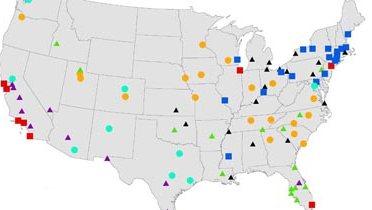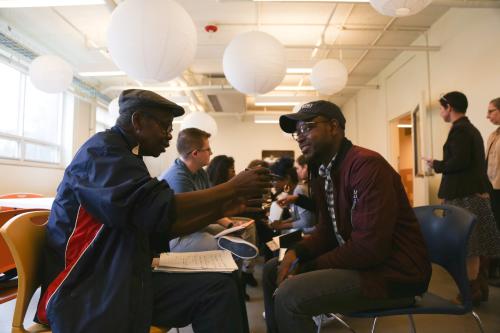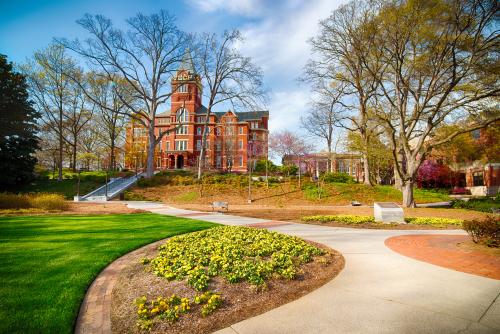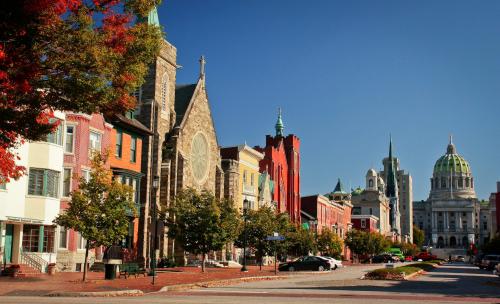U.S. cities and regions continue to focus significant energy on efforts to attract highly educated workers to their local marketplace (see here, here, and here for just a few examples). These efforts make sense, since human capital—often measured as the rate of higher educational attainment among the adult population—is among the most important contributors to growth in those advanced economies that specialize in knowledge-based industries. And the United States is a large, flexible labor market in which both native-born and foreign-born workers have historically sought economic opportunity outside the communities in which they grew up.
Of course, the stock of human capital in a region depends not only on which individuals that place is able to attract, but also on its success in nurturing and retaining a highly educated “home-grown” population. About half of all adults in large metro areas reside in the state of their birth, suggesting that they will remain a critical part of the economic and social fabric in these places.
To further dissect this relationship between migration and human capital, we examined data from the Census Bureau’s 2015 American Community Survey. The survey asks adults about their highest level of educational attainment, as well as their place of birth. We tabulated results to determine, for each of the 100 largest U.S. metropolitan areas, rates of four-year college degree attainment for prime working-age individuals (ages 25 to 54) living in the state of their birth, versus those born elsewhere (either in the United States or abroad). This is not a perfect measure of in-migration; individuals could have moved to these metro areas at any point in their lives (not necessarily as adults), and they could have moved from a different region within the same state (e.g., from Cleveland to Columbus). Nonetheless, three notable patterns emerge:
The metro areas that have attracted highly educated adult populations are an economically diverse group.
Among the metro areas with the highest rates of college degree attainment for individuals born out-of-state are knowledge capitals like the San Francisco Bay Area, Washington, D.C., Boston, Denver, and Seattle (see Table 1). Those regions have large numbers of jobs in sectors like software, professional services, sciences, and government that tend to employ highly educated workers.
At the same time, a number of former industrial centers make the list, too, including Baltimore, Pittsburgh, St. Louis, and Albany. Growing specializations in technology-driven industries, fueled in part by higher education and health care institutions, have attracted highly educated domestic and international migrants to these “brain belts.” And while their overall numbers remain relatively low, more than half of younger (ages 25 to 34) migrants to the Akron and Jackson, Miss. metro areas have a bachelor’s degree.
Table 1. Large metropolitan areas with the highest share of out-of-state prime-age adults with bachelor’s degrees, 2015
Rank |
Metro area |
Share of out-of-state adults with bachelor’s degrees |
| 1 | San Jose-Sunnyvale-Santa Clara, CA | 59.1 |
| 2 | Washington-Arlington-Alexandria, DC-VA-MD-WV | 56.0 |
| 3 | Boston-Cambridge-Newton, MA-NH | 55.9 |
| 4 | Baltimore-Columbia-Towson, MD | 55.2 |
| 5 | Madison, WI | 55.1 |
| 6 | San Francisco-Oakland-Hayward, CA | 54.1 |
| 7 | Pittsburgh, PA | 53.4 |
| 8 | Bridgeport-Stamford-Norwalk, CT | 52.5 |
| 9 | Raleigh, NC | 50.1 |
| 10 | Denver-Aurora-Lakewood, CO | 48.8 |
| 11 | Seattle-Tacoma-Bellevue, WA | 48.1 |
| 12 | Minneapolis-St. Paul-Bloomington, MN-WI | 47.7 |
| 13 | St. Louis, MO-IL | 47.4 |
| 14 | Albany-Schenectady-Troy, NY | 47.3 |
| 15 | Philadelphia-Camden-Wilmington, PA-NJ-DE-MD | 46.9 |
| 16 | Columbus, OH | 46.8 |
| 17 | Akron, OH | 46.2 |
| 18 | Richmond, VA | 45.8 |
| 19 | Austin-Round Rock, TX | 45.5 |
| 20 | Hartford-West Hartford-East Hartford, CT | 44.8 |
| 100 largest metro area total | 40.6 | |
| Note: Prime-age adults are aged 25 to 54; out-of-state adults include those born abroad | ||
| Source: Brookings analysis of 2015 American Community Survey microdata | ||
Many metro areas exhibit large educational attainment gaps between in-migrants and “locally sourced” adults.
On average, 41 percent of prime working-age adults in the 100 largest metro areas born outside their state of residence possess a bachelor’s degree, versus 33 percent of those living in their state of birth. This gap reflects the fact that highly educated people are more likely to move longer distances, both because they have more specialized skills that make them part of a national (versus regional) labor market, and because their higher earnings provide them with the resources to make those moves.Many metro areas exhibit large educational attainment gaps between in-migrants and “locally sourced” adults.
In several metro areas, however, the attainment gap between these two groups is much larger than the metropolitan average. Indeed, many revitalized industrial centers exhibit the widest gaps. In Baltimore, for instance, only 30 percent of 25 to 54 year-olds born in the state of Maryland possess a bachelor’s degree, versus 55 percent of those born elsewhere—a 25 percentage-point gap (see Table 2). Four Ohio metro areas—Akron, Cincinnati, Dayton, and Toledo—have among the largest gaps, as do Pittsburgh, Richmond, and St. Louis. It may be that in-migrants disproportionately create and fill new, higher-tech jobs and industries in these metro areas. At the same time, this trend could signal that relatively low rates of degree attainment among much larger local-grown populations are insufficient to power high-tech growth. Notably, Atlanta and Charleston—two urban centers of the “New South”—exhibit a similar pattern of above-average educational attainment among in-migrants, and below-average attainment among native residents of their respective states.
Table 2. Large metropolitan areas with the largest differences between bachelor’s degree attainment for prime-age adults born in-state versus out-of-state, 2015
|
|
|
Share of out-of-state adults with bachelor’s degrees |
Share of in-state adults with bachelor’s degrees |
|
| 1 | Baltimore-Columbia-Towson, MD | 55.2 | 30.2 | 24.9 |
| 2 | Pittsburgh, PA | 53.4 | 35.5 | 17.9 |
| 3 | Charlotte-Concord-Gastonia, NC-SC | 44.1 | 26.4 | 17.7 |
| 4 | St. Louis, MO-IL | 47.4 | 29.7 | 17.7 |
| 5 | Washington-Arlington-Alexandria, DC-VA-MD-WV | 56.0 | 38.5 | 17.5 |
| 6 | Richmond, VA | 45.8 | 29.2 | 16.6 |
| 7 | Akron, OH | 46.2 | 29.7 | 16.4 |
| 8 | San Jose-Sunnyvale-Santa Clara, CA | 59.1 | 43.1 | 16.0 |
| 9 | Dayton, OH | 40.8 | 25.9 | 14.9 |
| 10 | Toledo, OH | 39.9 | 25.1 | 14.8 |
| 11 | Tucson, AZ | 34.4 | 20.1 | 14.4 |
| 12 | Charleston-North Charleston, SC | 44.0 | 29.9 | 14.1 |
| 13 | Atlanta-Sandy Springs-Roswell, GA | 44.4 | 30.5 | 14.0 |
| 14 | Cincinnati, OH-KY-IN | 44.7 | 30.8 | 14.0 |
| 15 | Memphis, TN-MS-AR | 36.5 | 23.1 | 13.4 |
| 16 | Denver-Aurora-Lakewood, CO | 48.8 | 35.5 | 13.3 |
| 17 | Seattle-Tacoma-Bellevue, WA | 48.1 | 35.2 | 13.0 |
| 18 | Jacksonville, FL | 37.7 | 24.9 | 12.9 |
| 19 | Harrisburg-Carlisle, PA | 42.0 | 29.4 | 12.6 |
| 20 | Philadelphia-Camden-Wilmington, PA-NJ-DE-MD | 46.9 | 34.3 | 12.6 |
| 100 largest metro area total | 40.6 | 32.8 | 7.7 | |
| Note: Prime-age adults are aged 25 to 54; out-of-state adults include those born abroad | ||||
| Source: Brookings analysis of 2015 American Community Survey microdata | ||||
These gaps, combined with historical migration patterns, yield a number of metro areas in which the overwhelming majority of college degree holders were born outside the state.
In the average large metropolitan area, 59 percent of prime-age bachelor’s degree holders were born outside their current state of residence. But that share ranges from only 23 percent in Buffalo to a staggering 92 percent in Las Vegas. In fact, 20 of the 100 largest U.S. metro areas have effectively “imported” at least 70 percent of their highly educated workers from out of state (see Table 3). Most are Sun Belt metro areas (including seven in Florida and two in Arizona) in which—as in Las Vegas—most residents overall were born outside the state. Those metro areas have also experienced more lower-skilled migration from abroad, particularly Latin America, than other parts of the country.
Table 3. Large metropolitan areas with the largest shares of prime-age bachelor’s degree holders born out-of-state, 2015
|
Rank |
Metro area |
All adults with bachelor’s degrees |
Out-of-state adults with bachelor’s degrees |
Share of bachelor’s degree holders born out-of-state |
| 1 | Las Vegas-Henderson-Paradise, NV | 204,189 | 187,554 | 91.9 |
| 2 | Washington-Arlington-Alexandria, DC-VA-MD-WV | 1,398,968 | 1,200,927 | 85.8 |
| 3 | North Port-Sarasota-Bradenton, FL | 67,438 | 55,459 | 82.2 |
| 4 | Cape Coral-Fort Myers, FL | 53,393 | 43,569 | 81.6 |
| 5 | Colorado Springs, CO | 103,173 | 84,144 | 81.6 |
| 6 | Miami-Fort Lauderdale-West Palm Beach, FL | 809,370 | 639,104 | 79.0 |
| 7 | Orlando-Kissimmee-Sanford, FL | 318,813 | 246,797 | 77.4 |
| 8 | Phoenix-Mesa-Scottsdale, AZ | 552,467 | 424,358 | 76.8 |
| 9 | Tampa-St. Petersburg-Clearwater, FL | 364,281 | 273,531 | 75.1 |
| 10 | Deltona-Daytona Beach-Ormond Beach, FL | 52,303 | 39,235 | 75.0 |
| 11 | Tucson, AZ | 103,750 | 77,275 | 74.5 |
| 12 | Denver-Aurora-Lakewood, CO | 570,922 | 423,603 | 74.2 |
| 13 | San Jose-Sunnyvale-Santa Clara, CA | 460,870 | 341,794 | 74.2 |
| 14 | Palm Bay-Melbourne-Titusville, FL | 59,972 | 44,134 | 73.6 |
| 15 | Atlanta-Sandy Springs-Roswell, GA | 965,618 | 709,424 | 73.5 |
| 16 | Portland-Vancouver-Hillsboro, OR-WA | 407,816 | 298,266 | 73.1 |
| 17 | Bridgeport-Stamford-Norwalk, CT | 185,466 | 135,508 | 73.1 |
| 18 | Charlotte-Concord-Gastonia, NC-SC | 385,863 | 280,041 | 72.6 |
| 19 | Seattle-Tacoma-Bellevue, WA | 724,753 | 525,240 | 72.5 |
| 20 | Raleigh, NC | 267,632 | 190,083 | 71.0 |
| 100 largest metro area total | 32,637,394 | 19,313,202 | 59.2 | |
| Note: Prime-age adults are aged 25 to 54; out-of-state adults include those born abroad | ||||
| Source: Brookings analysis of 2015 American Community Survey microdata | ||||
These talent magnets face two potential risks. One is that their business communities, which have come to rely on imported talent, may underinvest in local systems designed to equip home-grown populations with access to critical skills and economic opportunities. This could further exacerbate the growing economic inequality that characterizes many regions with large in-state/out-of-state attainment differences, and threatens stable, long-term economic growth. A second risk stems from evidence that long-distance migration continues to decline, even among younger populations, which suggests limits to overreliance on an attraction strategy for regional human capital development.But there are also a number of “new economy” metro areas, including Washington, D.C., Denver, San Jose, Charlotte, and Seattle, in which the bulk of college degree holders hail from somewhere else. (Washington, D.C. is a bit of a special case in that it straddles two states and the District of Columbia, with significant residential movement among the three jurisdictions.) This attribute reflects the long-run strengths of these regional economies and their industries’ outsized demand for highly educated workers. At the same time, these places have relied disproportionately on the education and training systems of other cities and states—in the United States and around the world—to produce those workers.
Fortunately, business leaders in some regions are embracing the imperative to invest in the local talent pipeline. My colleague Amy Liu recently chronicled the case of Greater Seattle, where the business community is adopting bold goals to increase the educational attainment of kids from the state of Washington, to allow the region to meet significant projected demand for skilled workers.
U.S. cities and metro areas will continue to compete with one another for the best and brightest individuals from around the country and the globe—as well they should. Matching those efforts with equally forceful strategies to groom the best and brightest local talent should be on every region’s competitive agenda as well.








Commentary
The metro talent competition: attracting and growing highly educated workers
November 14, 2016